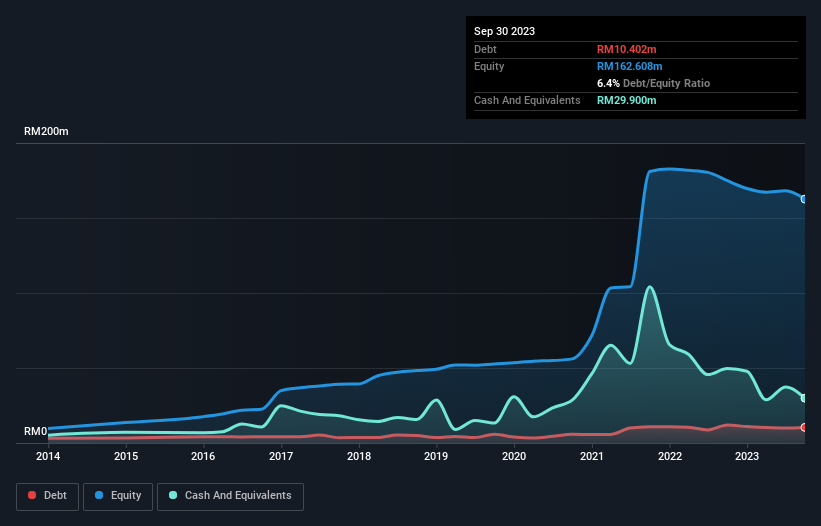- Malaysia
- /
- Trade Distributors
- /
- KLSE:BCMALL
Is BCM Alliance Berhad (KLSE:BCMALL) Using Debt In A Risky Way?
The external fund manager backed by Berkshire Hathaway's Charlie Munger, Li Lu, makes no bones about it when he says 'The biggest investment risk is not the volatility of prices, but whether you will suffer a permanent loss of capital.' When we think about how risky a company is, we always like to look at its use of debt, since debt overload can lead to ruin. Importantly, BCM Alliance Berhad (KLSE:BCMALL) does carry debt. But is this debt a concern to shareholders?
When Is Debt Dangerous?
Debt and other liabilities become risky for a business when it cannot easily fulfill those obligations, either with free cash flow or by raising capital at an attractive price. Ultimately, if the company can't fulfill its legal obligations to repay debt, shareholders could walk away with nothing. However, a more common (but still painful) scenario is that it has to raise new equity capital at a low price, thus permanently diluting shareholders. Of course, the upside of debt is that it often represents cheap capital, especially when it replaces dilution in a company with the ability to reinvest at high rates of return. When we think about a company's use of debt, we first look at cash and debt together.
Check out our latest analysis for BCM Alliance Berhad
How Much Debt Does BCM Alliance Berhad Carry?
As you can see below, BCM Alliance Berhad had RM10.4m of debt at September 2023, down from RM12.0m a year prior. But on the other hand it also has RM29.9m in cash, leading to a RM19.5m net cash position.

How Strong Is BCM Alliance Berhad's Balance Sheet?
We can see from the most recent balance sheet that BCM Alliance Berhad had liabilities of RM27.6m falling due within a year, and liabilities of RM8.62m due beyond that. Offsetting this, it had RM29.9m in cash and RM81.8m in receivables that were due within 12 months. So it can boast RM75.4m more liquid assets than total liabilities.
This excess liquidity is a great indication that BCM Alliance Berhad's balance sheet is almost as strong as Fort Knox. With this in mind one could posit that its balance sheet means the company is able to handle some adversity. Succinctly put, BCM Alliance Berhad boasts net cash, so it's fair to say it does not have a heavy debt load! There's no doubt that we learn most about debt from the balance sheet. But it is BCM Alliance Berhad's earnings that will influence how the balance sheet holds up in the future. So when considering debt, it's definitely worth looking at the earnings trend. Click here for an interactive snapshot.
In the last year BCM Alliance Berhad wasn't profitable at an EBIT level, but managed to grow its revenue by 6.0%, to RM100m. That rate of growth is a bit slow for our taste, but it takes all types to make a world.
So How Risky Is BCM Alliance Berhad?
We have no doubt that loss making companies are, in general, riskier than profitable ones. And in the last year BCM Alliance Berhad had an earnings before interest and tax (EBIT) loss, truth be told. Indeed, in that time it burnt through RM8.0m of cash and made a loss of RM11m. But the saving grace is the RM19.5m on the balance sheet. That means it could keep spending at its current rate for more than two years. Overall, its balance sheet doesn't seem overly risky, at the moment, but we're always cautious until we see the positive free cash flow. When analysing debt levels, the balance sheet is the obvious place to start. However, not all investment risk resides within the balance sheet - far from it. For example, we've discovered 3 warning signs for BCM Alliance Berhad that you should be aware of before investing here.
Of course, if you're the type of investor who prefers buying stocks without the burden of debt, then don't hesitate to discover our exclusive list of net cash growth stocks, today.
Valuation is complex, but we're here to simplify it.
Discover if BCM Alliance Berhad might be undervalued or overvalued with our detailed analysis, featuring fair value estimates, potential risks, dividends, insider trades, and its financial condition.
Access Free AnalysisHave feedback on this article? Concerned about the content? Get in touch with us directly. Alternatively, email editorial-team (at) simplywallst.com.
This article by Simply Wall St is general in nature. We provide commentary based on historical data and analyst forecasts only using an unbiased methodology and our articles are not intended to be financial advice. It does not constitute a recommendation to buy or sell any stock, and does not take account of your objectives, or your financial situation. We aim to bring you long-term focused analysis driven by fundamental data. Note that our analysis may not factor in the latest price-sensitive company announcements or qualitative material. Simply Wall St has no position in any stocks mentioned.
About KLSE:BCMALL
BCM Alliance Berhad
An investment holding company, distributes commercial laundry equipment, medical devices, and healthcare products in Malaysia and internationally.
Flawless balance sheet with low risk.
Market Insights
Community Narratives


Recently Updated Narratives

Astor Enerji will surge with a fair value of $140.43 in the next 3 years

Proximus: The State-Backed Backup Plan with 7% Gross Yield and 15% Currency Upside.


A case for for IMPACT Silver Corp (TSXV:IPT) to reach USD $4.52 (CAD $6.16) in 2026 (23 bagger in 1 year) and USD $5.76 (CAD $7.89) by 2030
Popular Narratives


MicroVision will explode future revenue by 380.37% with a vision towards success


The company that turned a verb into a global necessity and basically runs the modern internet, digital ads, smartphones, maps, and AI.



